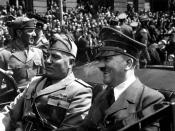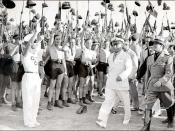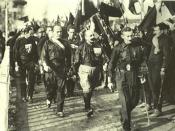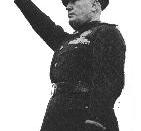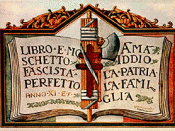The Fascist attitude towards women was rather conservative and can be seen as very sexist. They considered women to be the "angels of the hearth" who would stay home to take care of the house and the children, of whom they were supposed to have as many as possible so that the regime's demographic ambitions could be achieved. In Mussolini's own words, "Child bearing is woman s natural and fundamental role in life. Women should be exemplary wives and mothers, guardians of the hearth, and subject to the legitimate authority of their husbands". As Evans says, he saw women's primary function as to procreate and manage the family functions.
"Women must obey...my idea of her role in the state is in opposition to all feminism. Naturally she shouldn't be a slave, but if I conceded her the vote, I'd be laughed at. In our state, she must not count."
Most historians feel that this policy towards women became part of the fascist ideology for two reasons the first being that lower and middle class men felt threatened by the increase in women in workplaces. Also, unemployment was high. Mussolini realised that if he could get the women out of the workplace, he could reduce unemployment. Another reason for this discriminatory policy was the Vatican's view of women. The Catholic Church's view of women was as subordinate to men and it preached very rigid gender roles.
One of Mussolini's main aims when it came to his policy towards women was to increase the population of Italy. As Dena Renetti mentions, Italy was already overcrowded with 40 million people but Mussolini wanted a target of 20 million more people by 1950. Again, this was mainly due to his colonial interest. He believed that a greater population fulfill the needs of the army in order for greater territorial expansion. He took several measures in order to achieve his targets in this battle for births. Couples were exempted from marriage loans if they had more than four children and awards were given to mothers with more than 10 children. There were annual ceremonies celebrating the most prolific mothers. In 1933, 93 families had a total of 1300 children. And in 1939, mothers were awarded one silver bar for each child. This had mixed reactions towards it. A forty-year old mother after returning from one such prize ceremony , when asked about her future plans replied by saying, "I'll do it again". But as a Turin pediatrician reported, most working class mothers felt that they could not afford so many children. Also, according to a survey in 1937, most teenage girls between the ages of 14-18 did not want more than one or two children. Further, despite this, birth rate continued to decline.
Women are also discouraged from higher education and employment. In 925, women are given the right to vote in local elections, but in 1926m local elections were abolished. Now, as women had no more vote, they played no role in the running of the country. Jobs for women were limited by the quota system. In the mid 1920s, women were barred from certain teaching jobs. In 1933, the state imposed a limit of 10% on government jobs. In 1938, this was extended to many private firms. Many women were unhappy with this decree. The war had given them freedom, but the regime was taking it way. In 1938, with the establishment of this quota, a 40 year old Turinese spinster wrote to Mussolini, "Duce, Do you want to increase the number of suicides, prostitutes and emigrations"? However, no such decrees were laid down in the agricultural sector and millions continued to work in the farms. As a working class woman accounts, life was hard in rural Italy. This particular woman, apparently, spent an estimate of 1500 hours of working at home in addition to agricultural work in 1930. However, these decrees passed on women's employment had the opposite effect of what the Fascists actually wanted. As time went on, the number of women in universities increased(from 6% in1914 to 15% in 1938) as the compitietion for jobs among a few available jobs grew.Educating girls remained an important part of Fascist policy. But their curriculum taught them how to be good mothers and wives. The actual academic part of education was not for them. But despite this, as survey among 14-18 year old girls shows, girls remained "extraordinaly vague" about having families, studied in order to qualify for a job, did not expect their husband to support them, mostly uninterested in activities that were traditionally reserved for women and wanted to command rather than obey.
The Fascists also had a very firm idea of what a woman should look like. According to Evans, a family of 12 was seen as a norm in Fascist Italy. American and other Western influences like cosmetics, high heels, trousers for women, Negro and rhythm dancing were discouraged by the regime as immoral. A National Committee for Cleaning Up Fashion was created in order to clean up the "horrid vice" of scandalous fashions. But despite this, many Italian men went to cinemas to watch American movies in which they could catch glimpses of American actresses' breasts. Also, as Evans points out, most of the Fascist officials' wives and daughters rarely if ever, conformed to these norms and bought their clothes from Paris fashion houses and used French perfumes.
The Fascists also had a very confused attitude towards sports. On one hand, it would promote health, but on the other hand, it might promote lesbianism, feminism and distract women from their main role of procreation. Also, Mussolini believed that it could cause infertility.
In P. Wilson's words, "The femal experience of the fascist period was marked by its sheer diversity". There were just too many contradictions in their policy and also in reality for the fascists to achieve what they wanted. Despite separate educational curriculum towards women, girls continued to think for themselves and remained determined to create their own lives as indicated in the survey in 1937. The wives and daughters of fascist officials did not conform to the fascist ideals like they would be supposed to in order to create and example. There were many contradictions in the policy itself like in the fascist attitude to sports and the agricultural sector of employment. Also, despite all efforts, the birth rate actually fell during the fascist regime. In all, The fascist policy towards women was not very successful.
Bibliography: Evans, Hite and Hinton
